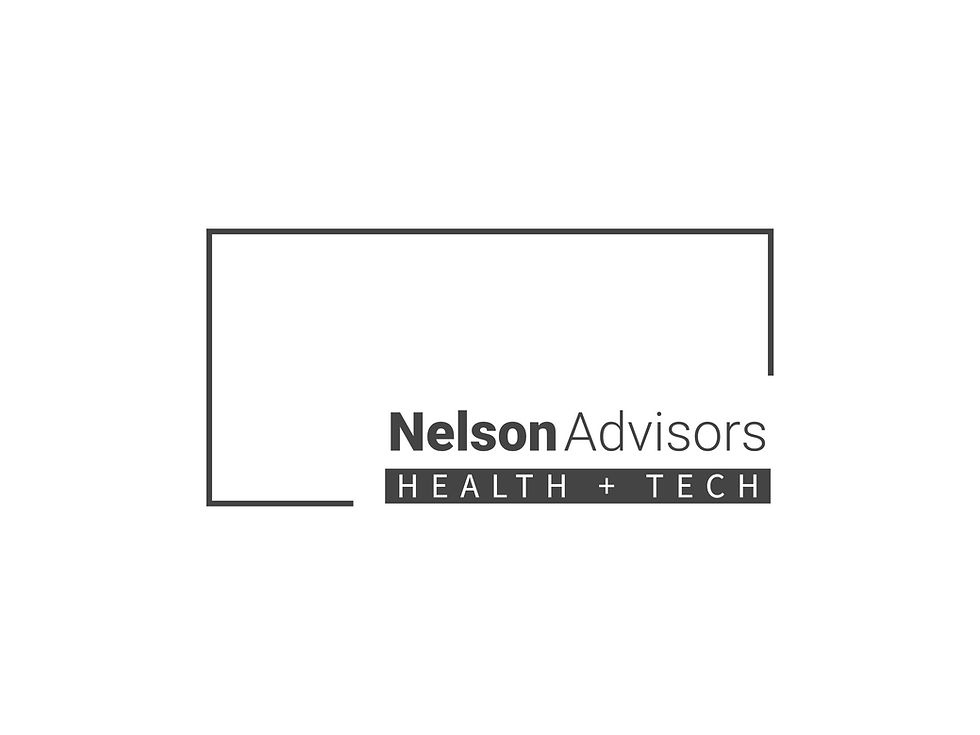The Venture Capital HealthTech Investment Thesis for Value Based Care
- Nelson Advisors

- Sep 23
- 14 min read

Executive Summary
This report provides a definitive analysis for venture capital (VC) investment in the value-based care (VBC) healthtech sector. While VBC represents a profound and necessary paradigm shift with a multi-trillion-dollar market opportunity, it is not an environment for unsophisticated capital. The core finding is a qualified "yes": venture capital should strategically back VBC healthtech, but only by targeting specific business models and deploying patient capital with a deep understanding of the unique operational, regulatory, and financial risks.
The market is propelled by a macroeconomic imperative to curb escalating costs and is strongly incentivised by top-down regulatory mandates from entities like CMS. However, startups face structural hurdles, including fragmented data ecosystems, notoriously long sales cycles, and resistance from entrenched stakeholders. Case studies of both successful exits (Oak Street Health, Signify Health) and spectacular failures (Cano Health, CareMax) confirm that the nature of the capital is as critical as the business model. The most promising opportunities lie in scalable "enabler" technologies and specialized "single slice" solutions that reduce administrative friction and empower providers to manage risk effectively.
The Macroeconomic Imperative for Value-Based Care
Market Landscape & Growth Trajectory: A Paradigm Shift
The shift to value-based care is not a passing trend but a fundamental reorientation of the U.S. healthcare system, moving from a volume-driven model to one centred on patient outcomes and cost-efficiency. The sheer scale of this transition presents a monumental opportunity. In 2024, the U.S. value-based healthcare service market was valued at an impressive $4.01 to $4.15 trillion. This is not a nascent market; it is a massive, established sector undergoing a profound transformation. Projections indicate a significant and sustained growth trajectory, with a Compound Annual Growth Rate (CAGR) of 7.2% to 7.5% over the next decade, with the market expected to reach up to $8.55 trillion by 2034.
This sustained, decade-long growth forecast signals an irreversible and strategic direction for the entire healthcare ecosystem. Analysing the market segments provides a clearer picture of where the momentum is concentrated. The Medicare and Medicare Advantage segments are the most mature, holding the largest revenue share at 48.48% in 2024. This is a critical point, as it shows that the most active and proven market for VBC innovation is tied directly to federal programs.
Furthermore, the self-care segment also held a dominant revenue share, accounting for 38.0% to 37.26% of the market, which underscores the increasing emphasis on patient-centric models that empower individuals to actively manage their health. Looking ahead, the Medicaid segment and the institutional care segment are expected to be the fastest-growing categories, highlighting emerging opportunities for new and innovative startups to address underserved populations and settings.
Core Principles & Driving Forces of Adoption
Value-based care represents a philosophical and financial departure from the traditional fee-for-service (FFS) model, where providers are reimbursed based on the quantity of services delivered, regardless of the outcomes. The core objective of VBC is to align financial incentives with patient well-being, focusing on improving health outcomes, enhancing the patient experience, and reducing costs. This holistic approach is often framed by the Quintuple Aim: improving the patient experience, enhancing population health, reducing per capita costs, supporting the well-being of the healthcare workforce, and advancing health equity. The economic imperative behind this shift is unmistakable; soaring healthcare costs and the increasing burden of chronic diseases have rendered the FFS model fiscally unsustainable, making a transition to more efficient, patient-centered care a necessity rather than an option.
Beyond market forces, government initiatives are a primary driver of VBC adoption. The U.S. Centers for Medicare & Medicaid Services (CMS) has set an ambitious and clear goal to have all Medicare beneficiaries in some form of VBC arrangement by 2030. This includes models like Accountable Care Organisations (ACOs) and bundled payment models, which are now being adopted by commercial insurers as well. The CMS GUIDE Model, for example, provides a new payment structure for dementia care that is compatible with existing models and is designed to help older adults with dementia stay healthy at home longer. This top-down mandate from the most influential payer in the U.S. healthcare system serves as a powerful de-risking factor for investors. The market's growth is not merely a function of organic demand; it is a direct result of government policy that provides a guaranteed, long-term demand for enabling solutions. This provides a strong tailwind for patient capital over a typical VC fund lifecycle of 10 or more years, establishing a clear and enduring market direction.
The sheer scale of the U.S. VBC market, already over $4 trillion, means that even small, incremental improvements can translate into enormous financial benefits. A study published in Health Affairs provides a powerful illustration of this, showing that VBC models have led to a 5.6% decrease in hospitalizations and a 9% decline in emergency department visits. In such a vast market, a 1% improvement in a key metric could result in billions of dollars in shared savings. This transforms the investment thesis: the focus is not solely on finding "disruptive" technologies but also on identifying "enabler" technologies that can deliver measurable, scalable, and auditable marginal gains. A startup's value proposition is therefore not just about a better product, but about a demonstrably lower cost of care for a defined patient population, making it an indispensable partner in the new healthcare economy.
US Value-Based Care Market Projections & Segment Breakdown
Metric | Details |
Market Size in 2024 | $4.01-$4.15 Trillion |
Projected Market Size by 2034 | $8.55 Trillion |
Compound Annual Growth Rate (CAGR) | 7.2% - 7.5% |
Forecast Period | 2024-2034 |
Largest Payer Category | Medicare and Medicare Advantage (48.48% revenue share in 2024) |
Fastest-Growing Payer Category | Medicaid |
Largest Service Category | Self-Care (37.26% - 38.0% revenue share in 2024) |
Fastest-Growing Service Category | Institutional Care |
The HealthTech Opportunity: Catalysing Value and Scale
Technology as a Foundational Enabler for VBC
The successful transition to a value-based care model is intrinsically linked to the adoption of advanced technology. VBC is fundamentally a data-driven model that requires sophisticated tools for managing patient populations and measuring outcomes. To succeed, startups must provide solutions that enable accurate patient attribution, risk stratification, and outcome measurement. The data that informs these decisions must be "accurate, complete, and timely", a requirement that traditional, fragmented health systems often struggle to meet.
Artificial intelligence (AI) has emerged as a key technology in this transition. The research indicates that every payer and provider surveyed reports using AI in some capacity. AI is delivering tangible results, with a majority of users reporting improved clinical decision-making, increased operational efficiency, and better patient outcomes. This has not gone unnoticed by investors; there was a 300% increase in investment in biopharma AI since 2023, with mega-deals over $100 million accounting for 71% of the total investment in the sector in 2024.
Beyond AI, the rise of telehealth and remote patient monitoring (RPM) is crucial for expanding care beyond the traditional clinical setting. These technologies enable a shift towards proactive and preventive care, allowing providers to manage chronic conditions remotely, reduce hospital risks, and ultimately lower costs. Policy changes, such as those that support the CMS GUIDE Model, are creating new reimbursement pathways for these remote services, solidifying their role as a core component of future VBC models.
Proven Business Models & Investment Theses
The investment landscape for VBC healthtech is characterized by a variety of models, each with its own approach to generating value and managing risk. Leading venture capital firms have developed distinct investment theses to capture this opportunity. General Catalyst, for instance, champions a "Health Assurance" thesis, aiming to transform healthcare from a "sick care" system into one that is proactive, accessible, and affordable.
Their vision is to build an integrated network of companies that co-create the necessary infrastructure for this new ecosystem, rather than operating in silos. Similarly, Andreessen Horowitz (a16z) has an investment thesis focused on "Healthtech Infrastructure," centred on rebuilding the fundamental "utilities and systems-of-record" that underpin all healthcare operations, data exchange, and interoperability.
Within these overarching theses, three distinct startup archetypes have emerged as particularly attractive investment targets:
"Own the Whole Pie": These companies build comprehensive, end-to-end platforms and take on full financial risk for a defined patient population. The prime example is Oak Street Health, which scaled a national Medicare Advantage platform and was acquired for $10.6 billion, demonstrating that controlling every patient touchpoint can lead to significant venture-scale returns.
"Own a Single Slice": This model involves companies that specialize in a high-value, high-cost segment of care. Companies like Strive Health (kidney care) and Thyme Care (oncology) become indispensable to payers by designing every element of their service to effectively manage risk within a specialised domain.
"Enable Others to Take Risk": These startups provide the technology and operational infrastructure to empower providers and payers to succeed in VBC arrangements without becoming direct care providers themselves. Aledade and Pearl Health are examples of companies that help independent physicians participate in ACOs by providing analytics, financial alignment, and operational support. Carrum Health provides a similar service for employers, offering a bundled payment platform for specific procedures.
The research highlights a critical and often overlooked dynamic in the sector: a "synchronization gap" between payers and providers. While a high percentage of both groups (97-100%) agree on their VBC goals, they are not collaborating at scale. This is not a failure of vision but a significant obstacle in execution, as only about a third of surveyed organisations rate their data integration capabilities as excellent. This fragmentation and lack of coordinated data exchange represent the single greatest investment opportunity. The most valuable VBC startups will be those that act as platforms to bridge this gap, creating a "single source of truth" and coordinated data exchange that aligns all stakeholders.
Furthermore, while AI is widely adopted, its full potential remains untapped due to a lack of trust. Concerns about "AI hallucinations," algorithmic transparency, and ethical oversight are widespread and are keeping many leaders cautious. This hesitation is a major bottleneck in a sector built on trust. The market is not just looking for powerful AI, but for trusted AI. This creates an opportunity for VCs to prioritize startups that embed responsible innovation into their core product design, with transparent algorithms, clear human oversight protocols, and robust cybersecurity. This focus on trust and ethics will be a key differentiator and a source of competitive advantage, enabling a startup to build a defensible moat in a rapidly evolving market.
VC Theses & Focus Areas in VBC Healthtech
Firm Name | Investment Thesis | Key Focus Areas | Notable Investments |
General Catalyst | "Health Assurance" | Applied AI, Care Delivery, Ecosystem Integration, Health Equity | Livongo, Mindstrong, Color |
Andreessen Horowitz | "Healthtech Infrastructure" | AI + Healthcare, Virtual-First, Provider Enablement, Healthcare x Fintech | Pearl Health, Fortuna Health |
Alumni Ventures | "Risk Management" | Specialized Care (Kidney, Oncology), In-home Care, Patient Engagement | Strive Health, Thyme Care, Hopscotch Health |
Optum Ventures | Strategic Healthcare Investment | Services, Technology, Care Delivery | 75+ portfolio companies |
Rock Health | Digital Health | Digital Health Exclusively | Omada Health, Collective Health |
In-Depth Due Diligence: Mitigating Significant Risk
Operational & Go-to-Market Hurdles
While the VBC market presents immense opportunities, it is also fraught with significant operational and go-to-market challenges that must be thoroughly vetted. The transition to VBC requires substantial upfront investments in technology, data analytics, and care coordination infrastructure, all with uncertain ROI timeframes. This financial uncertainty is compounded by frequent policy changes from entities like CMS, which can disrupt long-term business strategies. The primary reason these startups face a high capital burn is the notoriously long sales cycle. The average enterprise medical software deal takes 12 or more months to close, a "marathon" that can stifle revenue and frustrate teams. A typical deal involves as many as nine decision-makers from various departments, including IT, finance, and clinical staff. This bureaucratic, multi-stakeholder approval process can add months to the timeline, with a new electronic health record (EHR) system for a hospital potentially taking two years to finalise.
Beyond the sales process, a significant hurdle is stakeholder resistance. Despite the clear benefits, both providers and patients can be hesitant to adopt new models. Providers, who have operated under the fee-for-service model for decades, may be skeptical of qualitative metrics and fear a loss of revenue during the transition. Patient resistance is also a factor, as many are unaccustomed to the proactive, patient-empowered approach of VBC, and may be more inclined to seek care only when they are sick.
Regulatory and Compliance Minefields
The healthcare sector is a heavily regulated environment, and a failure to navigate this landscape can be a fatal flaw for a startup. Companies are advised to allocate a significant portion of their budget—20% to 30%—to regulatory affairs. A staggering 70% of healthtech startups report facing regulatory hurdles that delay their time to market, a problem that is exacerbated when compliance issues arise late in the product lifecycle.
A critical lesson from the industry is the disproportionate cost of these delays. A study by McKinsey & Co. reveals that a six-month delay to market can result in a 33% loss in profits over five years. This is a far more significant impact than a 50% budget overrun on a product launched on time, which results in only a 4% profit reduction over the same period. This data underscores a powerful, counter-intuitive truth: for healthtech, speed is a more critical factor for long-term profitability than budget adherence. VCs must be prepared to fund a longer, potentially over-budget runway if it means the startup can navigate regulatory approvals and sales cycles more quickly. Compliance requirements are extensive and non-negotiable, including data privacy (HIPAA, GDPR), clinical validation, quality management systems (ISO 13485), and post-market surveillance.
The Cautionary Tales of Financial Misalignment
The success of a VBC company is not solely dependent on its business model or technology; the nature of its capital is just as critical. The year 2024 provided a stark warning with the Chapter 11 bankruptcies of at least three private equity-backed VBC companies: Cano Health, CareMax, and Miami Beach Medical Group. These companies specialized in value-based primary care for vulnerable populations, including those dually eligible for Medicare and Medicaid. The cause of their collapse was not a flawed VBC model, but a direct result of "extractive financial strategies". These included leveraged buyouts and debt-funded shareholder dividends, which burdened the companies with substantial debt. In one instance, an investor extracted at least $575.7 million from a company through these strategies. This stands in stark opposition to the VBC goals of patient well-being and long-term value creation.
The collapse of these companies led to layoffs and clinic closures, demonstrating the fundamental incompatibility of short-term, debt-heavy financial models with the long-term, patient-centric nature of VBC. In contrast, successful, equity-backed VBC companies like Oak Street Health ($10.6B) and Signify Health ($8B) achieved massive exits through acquisition by corporate incumbents like CVS and Amazon.
The failures of Theranos and Haven also serve as powerful reminders that a company must have a defensible business model, clinical validation, and a foundation of trust to succeed. This highlights that venture capital, with its patient, equity-based approach, is the right kind of investor for this sector, as it aligns with the long-term, value-creation goals of the business, unlike the short-term, extractive models of some private equity firms.
VBC Startup Risk Matrix
Risk Category | Specific Risk | Key Data Points & Impact |
Financial | Upfront Capital & High Burn Rate | Requires substantial investment in technology and infrastructure with uncertain ROI. |
Go-to-Market | Notoriously Long Sales Cycle | Average enterprise deal takes 12+ months and involves 9+ decision-makers. |
Regulatory | Regulatory Delays & Costs | 70% of startups face regulatory hurdles; 6-month delay can cause a 33% profit loss over 5 years. |
Operational | Data Fragmentation | Only 33% of providers and 31% of payers have excellent data integration capabilities, creating a bottleneck. |
Stakeholder | Provider & Patient Resistance | Clinicians may fear revenue loss; patients may resist proactive care. |
Lessons from Success & Failure
Company Name | Outcome | Business Model | Financial Strategy | Key Lesson |
Oak Street Health | $10.6B Acquisition by CVS | "Own the Whole Pie" - National Medicare Advantage Platform | Equity-backed (VC) | Scalable risk management and end-to-end control of care delivery create immense value. |
Signify Health | $8B Acquisition by CVS | "Single Slice" - In-home Health Assessments and Bundled Payments | Equity-backed (VC) | Specialized expertise that enables others to take on risk can lead to lucrative exits. |
Cano Health | Chapter 11 Bankruptcy in 2024 | "Own the Whole Pie" - Primary Care for Dual-Eligibles | Debt-burdened (Private Equity) | Short-term, extractive financial strategies are fundamentally incompatible with VBC's long-term goals. |
Theranos | Bankruptcy & Dissolution | Diagnostics | Equity-backed (VC) | Without clinical validation, transparency, and trust, a business model will unravel regardless of its funding. |
The Final Verdict: A Strategic Framework for Investment
Based on the comprehensive analysis, venture capital should strategically back VBC healthtech startups. However, this is not a sector for unfocused or impatient capital. The investment must be highly strategic, with a deep understanding of the unique market dynamics, a clear eye on the risks, and a commitment to providing patient capital.
A Framework for Evaluating VBC HealthTech Startups
A successful investment thesis for VBC healthtech requires a robust due diligence framework that moves beyond traditional tech metrics. VCs should evaluate startups based on the following:
Team Composition: Does the founding team have a rare blend of deep healthcare industry expertise and scalable technology experience? This combination is essential for understanding clinical workflows and building defensible, integrated solutions.
Business Model & Defensibility: Does the startup have a clear, defensible business model? It should fall into one of the proven archetypes—"own a slice," "own the whole pie," or "enable others to take risk"—and its value proposition must be clearly centred on reducing costs and improving outcomes.
Data Strategy & Interoperability: A startup's plan to overcome data fragmentation and integrate with existing EHRs and clinical workflows is a core indicator of its potential for success. The value of the company is directly proportional to its ability to create a single, accurate, and integrated data layer that aligns all stakeholders.
Go-to-Market Strategy: The startup must have a clear and detailed plan for navigating the 12 or more month sales cycle and the multi-stakeholder approval process. This includes a well-defined channel strategy, whether it's targeting health systems, large employers, or payers.
Capital and Financial Model: The financial model must be aligned with the long-term, patient-centric nature of VBC. The runway must be sufficient to survive the extended sales and regulatory cycles, and the plan should not rely on short-term, extractive financial engineering.
Strategic Recommendations
To succeed in this sector, venture capital funds should adopt a highly selective and proactive investment strategy:
Prioritise "Enabler" and "Single Slice" Models: While "owning the whole pie" has yielded large exits, "enabler" and "single slice" models often represent more capital-efficient and defensible businesses. These companies provide the foundational infrastructure that empowers the broader market and addresses high-value pain points.
Invest in Data & AI: The greatest market inefficiency is the "synchronization gap" between payers and providers. VCs should back startups that are not just using data and AI but are building a trusted, transparent, and integrated data layer that solves the industry's fragmentation problem.
Support Solutions that Reduce Administrative Burden: A key part of the Quintuple Aim is supporting the healthcare workforce. Startups that reduce administrative load for providers, automate reporting, and streamline workflows will have a powerful value proposition that drives adoption and reduces a major pain point.
Provide Patient Capital: Understand that this is a long-term play. Be prepared to deploy patient capital with a multi-year horizon, recognizing the extended sales, regulatory, and implementation cycles. This is an environment where the right kind of capital is a competitive advantage.
Concluding Outlook
The VBC healthtech market is at a critical juncture, moving from a theoretical vision to widespread implementation. However, the true potential of this transition is being bottlenecked by operational fragmentation and a lack of synchronised execution. For venture capitalists, this presents a sector with a clear, macroeconomic tailwind and an abundance of problems ripe for technology-driven solutions.
The potential for venture-scale returns, demonstrated by multi-billion-dollar exits like Oak Street Health and Signify Health, is a powerful motivator. But as the cautionary tales of debt-laden failures show, success is contingent not only on a powerful business model but also on a financial strategy that is fundamentally aligned with the long-term, patient-centric goals of value-based care.
The opportunity is immense, but it is reserved for those who choose to back companies that are built for enduring health, not short-term financial extraction.
Nelson Advisors > MedTech and HealthTech M&A
Nelson Advisors specialise in mergers, acquisitions and partnerships for Digital Health, HealthTech, Health IT, Consumer HealthTech, Healthcare Cybersecurity, Healthcare AI companies based in the UK, Europe and North America. www.nelsonadvisors.co.uk
Nelson Advisors regularly publish Healthcare Technology thought leadership articles covering market insights, trends, analysis & predictions @ https://www.healthcare.digital
We share our views on the latest Healthcare Technology mergers, acquisitions and partnerships with insights, analysis and predictions in our LinkedIn Newsletter every week, subscribe today! https://lnkd.in/e5hTp_xb
Founders for Founders > We pride ourselves on our DNA as ‘HealthTech entrepreneurs advising HealthTech entrepreneurs.’ Nelson Advisors partner with entrepreneurs, boards and investors to maximise shareholder value and investment returns. www.nelsonadvisors.co.uk
#NelsonAdvisors #HealthTech #DigitalHealth #HealthIT #Cybersecurity #HealthcareAI #ConsumerHealthTech #Mergers #Acquisitions #Partnerships #Growth #Strategy #NHS #UK #Europe #USA #VentureCapital #PrivateEquity #Founders #BuySide #SellSide#Divestitures #Corporate #Portfolio #Optimisation #SeriesA #SeriesB #Founders #SellSide #TechAssets #Fundraising#BuildBuyPartner #GoToMarket #PharmaTech #BioTech #Genomics #MedTech
Nelson Advisors LLP
Hale House, 76-78 Portland Place, Marylebone, London, W1B 1NT
Meet Us @ HealthTech events
Digital Health Rewired > 18-19th March 2025 > Birmingham, UK
NHS ConfedExpo > 11-12th June 2025 > Manchester, UK
HLTH Europe > 16-19th June 2025, Amsterdam, Netherlands
Barclays Health Elevate > 25th June 2025, London, UK
HIMSS AI in Healthcare > 10-11th July 2025, New York, USA
Bits & Pretzels > 29th Sept-1st Oct 2025, Munich, Germany
World Health Summit 2025 > October 12-14th 2025, Berlin, Germany
HealthInvestor Healthcare Summit > October 16th 2025, London, UK
HLTH USA 2025 > October 18th-22nd 2025, Las Vegas, USA
Web Summit 2025 > 10th-13th November 2025, Lisbon, Portugal
MEDICA 2025 > November 11-14th 2025, Düsseldorf, Germany
Venture Capital World Summit > 2nd December 2025, Toronto, Canada




















































Comments